- Apple has cut Vision Pro production due to low demand for the $3,500 mixed reality headset in the US. Apple now expects Vision Pro shipments to decline year on year in 2025, prompting Apple to review and adjust its product roadmap; plans for a second Vision Pro in 2025 are now reportedly on hold.
- Apple failed in its iPad Pro advertisement: The “Crush! ” commercial shows things like a piano, record player, paint, and other works flattening under the pressure of a hydraulic press, causing a lot of criticism.
- One of the fathers of communication, McLuhan developed the theory that the medium is an extension of the human senses. This theory of communication can also be applied to advertising strategies for products such as VR. We can’t help wonder where are the limits of our imagination for VR devices.
Not too long ago, a short video of Stanford students studying inside the school corridor using Apple’s Vision Pro product went viral on TikTok. The video showed many Stanford students in the crowd wearing very conspicuous VR equipment and pinching at the air – making it seem like a very cool, if creepy, and novel thing to do.
Do you remember the moment when Apple launched its Vision Pro? Apple’s Vision Pro virtual reality headset officially launched in the U.S. on February 2, 2024. All of a sudden everyone was talking about VR and the metaverse.
But three months on, Vision Pro’s commercial track record isn’t so good——Apple has cut Vision Pro production due to low demand for the reality headset because of a sharp fall-off in demand in the US. Between 160,000 and 180,000 of the spatial computing devices were sold in preorders before the February launch. But sales quickly slowed after that early burst of interest and Apple now takes a “conservative view” of demand outside of the US.
Apart from the obvious reason – the headset cost $3,600 – there seem to be several other reasons that led to this conceptually ideal and pioneering product facing Waterloo in terms of commercial sales.
McLuhan’s theory: Medium is an extension of the human senses
One of the fathers of communication, McLuhan proposed a famous theory: Medium is an extension of the human senses, implying that the form of a medium (such as television, radio, or the internet) embeds itself in the message it conveys, creating a symbiotic relationship between the two.
“The medium is the message.”
McLuhan, one of the fathers of communication
In his opinion, each medium extends or enhances some aspect of human capability or sense. For instance, the printing press extends the reach of our eyes and hands, enabling us to communicate and access information across distances and time. Similarly, television extends the visual sense by bringing distant events and images into our living rooms, altering our perception of space and time.
By understanding this concept, we recognise that different media alter our sensory perceptions and cognitive processes, and he urged us to become more aware of how media shape our perceptions, behaviors, and interactions with the world.
Vision Pro: Good intentions, failure in commercial
Many people believe that this is a cross-generation product, this product with eye tracking and gesture recognition technology will only appear in the Avengers kind of sci-fi film inside the air screen has become a reality. ‘The future is coming too fast’, this maybe you and I just watched the Apple Vision Pro launch event will make a sigh.
“Vision Pro is tomorrow’s technology today .”
Tim Cook, CEO of Apple
According to McLuhan’s theory, the Vision Pro’s design of the product’s interaction with the human body defeats this purpose. On the Chinese website Bilibili, there is a million fans influencer in the technology area (Hello, my name is He, who also owns a YouTube page), who is also an expert in the field of electronic product evaluation.
In his review videos for Vision Pro, he pointed out that this product does have a lot of innovative selling points (carrying a 55-inch screen) but wanting to fully integrate the Vision Pro into the life of the inside is almost impossible. The product’s eye-tracking and gesture-recognition technology is certainly sensitive and responsive, but it’s also difficult to perform more complex operations. You can of course give it an external Magic Keyboard and Magic Trackpad- then its productivity in the work sphere – can reach the level of a regular Mac.
Another thing that prevents the VP from succeeding is its 630g gram weight and the fact that its centre of gravity is located entirely at the front, resulting in facial muscles that can be unusually fatiguing; you may be in a dangerous situation when you turn off Vision Pro Perspective, but when you turn it on the VS doesn’t have enough pixels to allow you to see the world in a completely real way, and to the uninitiated, it looks like your eyes inside the vision pro inside your eyes will look a bit like aliens. So, Vision Pro as a technical medium, in a way not only doesn’t stretch your senses, it also limits the normal five senses that some humans have.
Also read: Where did the metaverse go? And will Apple’s Vision Pro bring it back?

IPad Pro ad cause discomfort
Apple introduced the M4-powered iPad Pro on May 7. To advertise all the creative possibilities with the iPad, it released a “Crush!” commercial that shows things like a piano, record player, paint, and other works flattening under the pressure of a hydraulic press. This advert has triggered a deep sense of techno-moral anxiety among people – the future is so bad, the piano and radio, such vibrant and dynamic experiences, are going to be compressed into a piece of cold metal, and human beings are going to become numb and boring. But if we reverse the adverts, the experience will be much better – the piano and radio extend from the iPad, it is the iPad’s condensed human intelligence that expands our senses, rather than our senses being crushed, and compressed into a machine.
Also read: Apple releases latest iPads with M4 chip

Pop Quiz
What do you think is the primary reason for the failure of Apple’s Vision Pro in the market?
A. Lack of innovative features
B. High price and ergonomic issues
C. Limited availability in the US market
D. Poor advertising strategy
The correct answer is at the bottom of the article.
Where is the VR future?
There are many more VR products on the market, for example Oculus Ques 2 offers a compelling mix of affordability and performance and it has become a popular choice for both casual users and VR enthusiasts; PlayStation VR is designed specifically for the PlayStation 4 and PlayStation 5 gaming consoles, PSVR brings immersive virtual reality experiences to console gamers; Google Card, as one of the most accessible VR devices, its transforms smartphones into makeshift VR headsets. But none of the products mentioned above have gone mainstream yet. Many of them focus on gaming industry and It’s a long way from everyday life.
VR trends point to a paradigm shift in the way we interact with digital content. As it stands today, virtual reality is supposed to be far from a simple amusement tool. It’s an immersive, transformative, and social technology reshaping industries and how we perceive reality. From education and entertainment to business and social interactions, VR could be applied in various facets of our lives.
Looking forward, the future of virtual reality promises to be nothing short of revolutionary. While current trends offer a glimpse into its potential, the true scope of VR’s possibilities remains vast and largely unexplored, inviting us to eagerly anticipate what lies ahead in this exhilarating digital journey.
At the forefront of technological innovation stands the metaverse, an extraordinary digital universe accessible through virtual reality. Here, users can seamlessly replicate numerous real-world activities within a virtual domain. Unlike conventional VR applications, which function in isolation, the metaverse integrates all services and applications, ensuring a seamless and uninterrupted user experience. This captivating development is poised to become a defining trend in the realm of virtual reality, reshaping the way we interact with digital environments and each other.
“The future holds the potential for seamless transitions between the real world and the metaverse, leaving us pondering the importance of each. One thing is certain, whether we embrace it or not, the metaverse is bound to reshape the world.”
Chen Gang , professor from Peking University
We look forward to a future of even more exciting VR products: perhaps, everything in the film’s number one player will come true. On top of respecting and extending our human senses, we look forward to embracing a more advanced and interesting future.
The correct answers is B.High price and ergonomic issues mentioned in the article, feel free to hold your own opinion.

